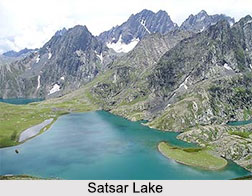 Satsar Lake or Sat Sar, which is also known as the seven lake, attracts the national and international tourists, as it has the natural beauty in the midst of Himalayan Mountain Range and Pir Panjal Range in India.
Satsar Lake or Sat Sar, which is also known as the seven lake, attracts the national and international tourists, as it has the natural beauty in the midst of Himalayan Mountain Range and Pir Panjal Range in India.
Location of Satsar Lake
Satsar Lake consists of seven small alpine lakes situated in the Kashmir Valley of Jammu and Kashmir in Ganderbal district.
Geography of Satsar Lake
Satsar Lake consists of seven small lakes connected with each other, set in a cascade formation. Satsar Lake is situated in a narrow alpine valley stretching from north to south and spread over 4 kilometres distance with a width of 1 kilometre (0.62 mi).
Landforms near Satsar Lake
The lakes of Gangabal and Nundkol lie on the opposite side of Zajibal pass (4,041 metres (13,258 ft)). Satsar Lakes are surrounded by lush green meadows which are home to shepherds during summer and serve as a camping site for tourists. Naranag is the nearest settlement and serves as the base camp for trekking to the lake in the summer.
Formation of Satsar Lake
Satsar Lake is mainly fed by melting snow. During the late summer and autumn, two or three lakes usually dry up, depending upon the precipitation. These lakes give rise to a stream which disappears and flows underground, from the side by glacier a stream originates and flows down southwards and falls into Wangath Nallah through Churnar which is the major right tributary of the Sindh River.
Satsar Lake inn Winter Months
During the winter, Satsar Lakes are covered by heavy snow. The basin of the lake is surrounded by a sheet of alpine flowers in the summer; the geum, blue poppy, potentilla and gentian are relatively common. Hedysarum flowers are found in late spring throughout the area around the lake. All seven lakes are stocked with trout, mainly brown trout. Licensed anglers are permitted to fish in the lakes, although permission has to be obtained from Srinagar in advance.
Accessibility in Satsar Lake
Satsar Lakes are accessible only during the summer; during the winter, the treks are closed because of the heavy snowfall.
Visiting Information
Satsar can be reached from Srinagar, via a 65 km motorable road which leads through Ganderbal and Wayil to the Naranag trekking camp. The alpine meadows of Trunakhul and Badpathri and the lakes of Nundkol and Gangabal Lake lie along the route. An alternate trek starts from Chattergul village, 10 km to the west of Naranag, which leads through the meadows of Mahlish. The lake can also be accessed through Bandipora and the six-day trekking starting point is Arin. It can also be accessed through Gurais via Tulail. Tourists prefer to take the Naranag trek and return via Gadsar Lake, Vishansar Lake and Sonamarg or vice versa to cover most alpine lakes of the area.
Related Articles
Ganderbal District, Jammu and Kashmir
Gadsar Lake, Ganderbal District, Jammu and Kashmir
Wangath Temple, Ganderbal district, Jammu and Kashmi
Wular Lake
Jammu and Kashmir
Lakes of India
Lidder Valley, Anantanag District, Jammu and Kashmir
Tourism In Jammu And Kashmir















